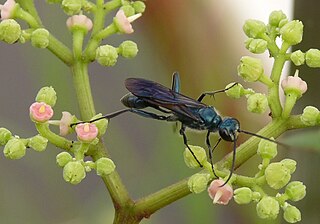
The Anacardiaceae, commonly known as the cashew family or sumac family, are a family of flowering plants, including about 83 genera with about 860 known species. Members of the Anacardiaceae bear fruits that are drupes and in some cases produce urushiol, an irritant. The Anacardiaceae include numerous genera, several of which are economically important, notably cashew, mango, poison ivy, sumac, smoke tree, marula, yellow mombin, Peruvian pepper and cuachalalate. The genus Pistacia is now included, but was previously placed in its own family, the Pistaciaceae.

Tabernanthe is a genus of flowering plants in the family Apocynaceae, first described as a genus in 1888. It is native to tropical central Africa.

Adrien René Franchet was a French botanist, based at the Paris Muséum national d'Histoire naturelle.

The Congo peafowl, known as the African peafowl or mbulu by the Bakôngo, is a species of peafowl native to the Congo Basin. It is one of three extant species of peafowl and the only member of the subfamily native to Africa, the other two being the Indian peafowl and the green peafowl.

Tabernaemontana is a genus of flowering plants in the family Apocynaceae. It has a pan-tropical distribution, found in Asia, Africa, Australia, North America, South America, and a wide assortment of oceanic islands. These plants are evergreen shrubs and small trees growing to 1–15 m tall. The leaves are opposite, 3–25 cm long, with milky sap; hence it is one of the diverse plant genera commonly called "milkwood". The flowers are fragrant, white, 1–5 cm in diameter.
Necepsia is a plant genus of the family Euphorbiaceae first described as a genus in 1910. It is native to Madagascar and to tropical Africa.
- Necepsia afzeliiPrain - Liberia, Sierra Leone, Ivory Coast, Ghana, Cameroon, Congo, Cabinda, Gabon
- Necepsia castaneifolia(Baill.) Bouchat & J.Léonard - Tanzania, Zimbabwe, Madagascar
- Necepsia zairensisBouchat & J.Léonard - Congo, Zaire

Panda is a plant genus of the family Pandaceae. It contains only one known species, Panda oleosa, native to western and central Africa.

Ancistrocladus is a genus of woody lianas in the monotypic family Ancistrocladaceae. The branches climb by twining other stems or by scrambling with hooked tips. They are found in the tropics of the Old World.
Thomandersia is the sole genus in the Thomandersiaceae, an African family of flowering plants. Thomandersia is a genus of shrubs and small trees, with six species native to Central and West Africa.
Hunteria is a genus of plants in the family Apocynaceae first described as a genus in 1824. It is native to Africa and to South and Southeast Asia.
- Hunteria ballayiHua - Central African Republic, Republic of Congo, Cameroon, Gabon
- Hunteria camerunensisK.Schum. ex Hallier f. - Republic of Congo, Cameroon, Gabon
- Hunteria congolanaPichon - Republic of Congo, Zaïre, Kenya
- Hunteria densifloraPichon - Zaïre
- Hunteria ghanensisJ.B.Hall & Leeuwenb. - Ivory Coast, Ghana
- Hunteria hexaloba(Pichon) Omino - Gabon
- Hunteria macrosiphonOmino - Republic of Congo, Gabon
- Hunteria myrianthaOmino - Zaïre
- Hunteria oxyanthaOmino - Republic of Congo, Zaïre, Gabon
- Hunteria simii(Stapf) H.Huber - Guinea, Ivory Coast, Liberia, Sierra Leone
- Hunteria umbellata(K.Schum) Hallier f. - W + C Africa from Senegal to Zaïre
- Hunteria zeylanica(Retz.) Gardner ex Thwaites - Somalia, Kenya, Tanzania, Mozambique, S China, India, Sri Lanka, Andaman & Nicobar Islands, Indochina, W Malaysia, Sumatra

Mimusops is a genus of plants in the family Sapotaceae described as a genus by Linnaeus in 1753.
Tieghemella is a genus of the plant family Sapotaceae described as a genus in 1890. The wood of Tieghemella species is known as makore in the lumber trade.
Lechytia is a genus of pseudoscorpions in the family Lechytiidae within the superfamily Chthonioidea. It is the sole genus in its family and contains 22 described species from many parts of the world.
Michelsonia is a genus of tree in the legume family, Fabaceae, where it is classified in the subfamily Detarioideae. It is a monotypic genus, the only species being Michelsonia microphylla. It is native to the tropical rain forests of the Democratic Republic of the Congo. The wood is used locally for construction work.
Richardsiella is a genus of plants in the grass family. The only known species in this genus is Richardsiella eruciformis, native to the Democratic Republic of the Congo and Zambia.

Chalybion is a genus of blue mud dauber wasps in the family Sphecidae.
Craterispermum is a genus of flowering plants in the family Rubiaceae. It contains 16 species that occur in tropical Africa and Seychelles. It is the only genus in the tribe Craterispermeae, of which the divergence time is estimated at 34.8 million years ago.
Catalepidia is a genus of a sole described species of medium-sized trees, constituting part of the plant family Proteaceae. The species Catalepidia heyana grows naturally only in a restricted mountain region (endemic) of the wet tropics rain forests of north-eastern Queensland, Australia. Common names include Hey's nut or Hey's nut oak.

Pleiocarpa is a genus of plant in the family Apocynaceae first described as a genus in 1876. It is native to tropical Africa from Senegal to Tanzania and south to Zimbabwe. As of August 2013 the World Checklist of Selected Plant Families recognises 6 species:
- Pleiocarpa bicarpellataStapf - Cabinda, Cameroon, Republic of Congo, Gabon, Zaire, Kenya
- Pleiocarpa brevistylaOmino - Gabon
- Pleiocarpa muticaBenth. - Ghana, Ivory Coast, Liberia, Sierra Leone, Nigeria, Cameroon, Gabon, Central African Republic, Republic of Congo
- Pleiocarpa picralimoides(Pichon) Omino - Cabinda, Republic of Congo, Gabon
- Pleiocarpa pycnantha(K.Schum) Stapf - widespread across most of tropical Africa
- Pleiocarpa rostrataBenth. - Nigeria, Cameroon, Gabon
- Pleiocarpa camerunensis(K.Schum. ex Hallier f.) Stapf = Hunteria camerunensisK.Schum. ex Hallier f.
- Pleiocarpa hockiiDe Wild. - Acokanthera oppositifolia(Lam.) Codd
- Pleiocarpa simii(Stapf) Stapf ex Hutch. & Dalziel = Hunteria simii(Stapf) H.Huber
Farquharia is a genus of flowering plants in the family Apocynaceae, first described as a genus in 1912. It contains only one recognized species, Farquharia elliptica, native to tropical western and central Africa.









